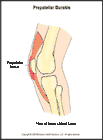
Prepatellar (Knee) Bursitis
What is prepatellar bursitis?
Prepatellar bursitis is an irritation or inflammation of a bursa in your knee. A bursa is a fluid-filled sac that acts as a cushion between tendons, bones, and skin.
There are several bursae in the knee. The prepatellar bursa is located just in front of the kneecap near the attachment of the kneecap (patellar) tendon. Prepatellar bursitis is also called housemaid's knee from when maids were injured cleaning floors on their knees. The injury is common in wrestlers, who get it from their knees rubbing on the mats. Volleyball players get it from diving onto their knees for the ball.
How does it occur?
Bursitis can result from:
- overuse
- a direct blow to the area
- chronic friction, such as from frequent kneeling.
What are the symptoms?
Prepatellar bursitis causes pain and swelling over the front of the knee. You may have pain when you bend or straighten your leg.
How is it diagnosed?
Your health care provider will examine your knee for tenderness over the bursa.
How is it treated?
Treatment may include:
- using ice packs on your knee for 20 to 30 minutes every 3 to 4 hours for 2 or 3 days or until the pain goes away
- wrapping an elastic bandage around your knee to reduce any swelling or to prevent swelling from occurring
- taking anti-inflammatory medication
- removal by your health care provider of some of the fluid within the bursa if it is very swollen
- injection of a corticosteroid medication into the swollen bursa
- leg stretching exercises.
When can I return to my sport or activity?
The goal of rehabilitation is to return you to your sport or activity as soon as is safely possible. If you return too soon you may worsen your injury, which could lead to permanent damage. Everyone recovers from injury at a different rate. Return to your sport or activity will be determined by how soon your knee recovers, not by how many days or weeks it has been since your injury occurred. In general, the longer you have symptoms before you start treatment, the longer it will take to get better.
You may safely return to your sport or activity when, starting from the top of the list and progressing to the end, each of the following is true:
- Your injured knee can be fully straightened and bent without pain.
- Your knee and leg have regained normal strength compared to the uninjured knee and leg.
- Your knee bursa is not swollen or tender to touch.
- You are able to put pressure on your bursa (such as kneeling) without pain or swelling.
- You are able to jog straight ahead without limping.
- You are able to sprint straight ahead without limping.
- You are able to do 45-degree cuts.
- You are able to do 90-degree cuts.
- You are able to do 20-yard figure-of-eight runs.
- You are able to do 10-yard figure-of-eight runs.
- You are able to jump on both legs without pain and jump on the injured leg without pain.
How can I prevent prepatellar bursitis?
Prepatellar bursitis is best prevented by avoiding direct blows to the kneecap area and by avoiding prolonged kneeling. Proper protective kneepads will help prevent inflammation of the bursa.

